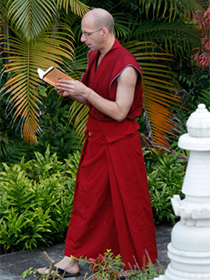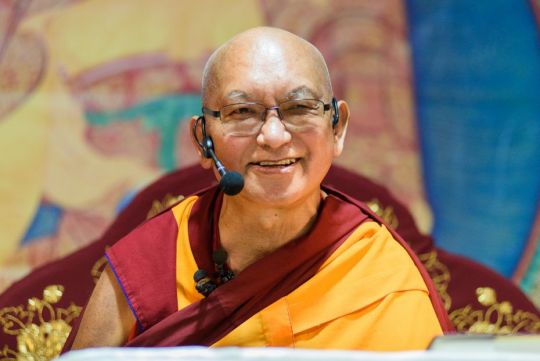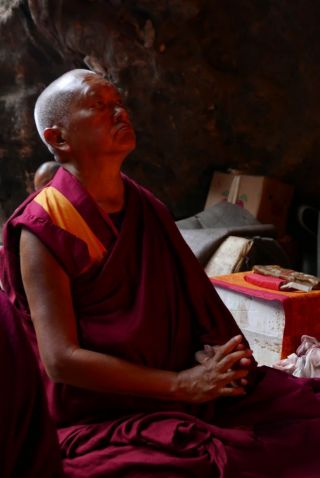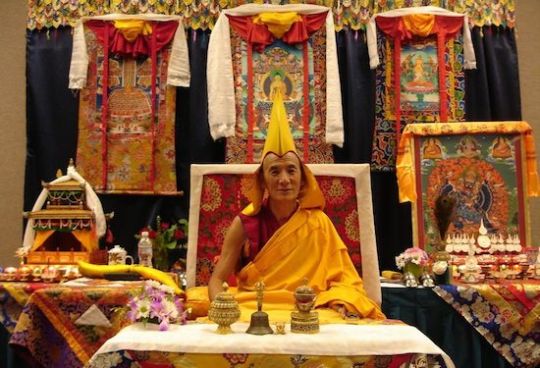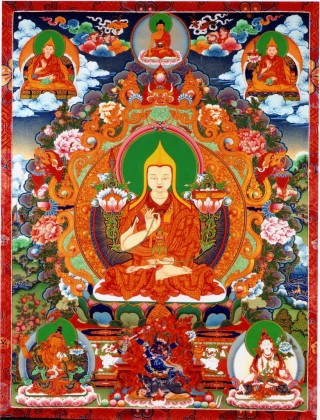- Home
- FPMT Homepage
Foundation for the Preservation of the Mahayana Tradition
The FPMT is an organization devoted to preserving and spreading Mahayana Buddhism worldwide by creating opportunities to listen, reflect, meditate, practice and actualize the unmistaken teachings of the Buddha and based on that experience spreading the Dharma to sentient beings. We provide integrated education through which people’s minds and hearts can be transformed into their highest potential for the benefit of others, inspired by an attitude of universal responsibility and service. We are committed to creating harmonious environments and helping all beings develop their full potential of infinite wisdom and compassion. Our organization is based on the Buddhist tradition of Lama Tsongkhapa of Tibet as taught to us by our founders Lama Thubten Yeshe and Lama Thubten Zopa Rinpoche.
- Willkommen
Die Stiftung zur Erhaltung der Mahayana Tradition (FPMT) ist eine Organisation, die sich weltweit für die Erhaltung und Verbreitung des Mahayana-Buddhismus einsetzt, indem sie Möglichkeiten schafft, den makellosen Lehren des Buddha zuzuhören, über sie zur reflektieren und zu meditieren und auf der Grundlage dieser Erfahrung das Dharma unter den Lebewesen zu verbreiten.
Wir bieten integrierte Schulungswege an, durch denen der Geist und das Herz der Menschen in ihr höchstes Potential verwandelt werden zum Wohl der anderen – inspiriert durch eine Haltung der universellen Verantwortung und dem Wunsch zu dienen. Wir haben uns verpflichtet, harmonische Umgebungen zu schaffen und allen Wesen zu helfen, ihr volles Potenzial unendlicher Weisheit und grenzenlosen Mitgefühls zu verwirklichen.
Unsere Organisation basiert auf der buddhistischen Tradition von Lama Tsongkhapa von Tibet, so wie sie uns von unseren Gründern Lama Thubten Yeshe und Lama Thubten Zopa Rinpoche gelehrt wird.
- Bienvenidos
La Fundación para la preservación de la tradición Mahayana (FPMT) es una organización que se dedica a preservar y difundir el budismo Mahayana en todo el mundo, creando oportunidades para escuchar, reflexionar, meditar, practicar y actualizar las enseñanzas inconfundibles de Buda y en base a esa experiencia difundir el Dharma a los seres.
Proporcionamos una educación integrada a través de la cual las mentes y los corazones de las personas se pueden transformar en su mayor potencial para el beneficio de los demás, inspirados por una actitud de responsabilidad y servicio universales. Estamos comprometidos a crear ambientes armoniosos y ayudar a todos los seres a desarrollar todo su potencial de infinita sabiduría y compasión.
Nuestra organización se basa en la tradición budista de Lama Tsongkhapa del Tíbet como nos lo enseñaron nuestros fundadores Lama Thubten Yeshe y Lama Zopa Rinpoche.
A continuación puede ver una lista de los centros y sus páginas web en su lengua preferida.
- Bienvenue
L’organisation de la FPMT a pour vocation la préservation et la diffusion du bouddhisme du mahayana dans le monde entier. Elle offre l’opportunité d’écouter, de réfléchir, de méditer, de pratiquer et de réaliser les enseignements excellents du Bouddha, pour ensuite transmettre le Dharma à tous les êtres. Nous proposons une formation intégrée grâce à laquelle le cœur et l’esprit de chacun peuvent accomplir leur potentiel le plus élevé pour le bien d’autrui, inspirés par le sens du service et une responsabilité universelle. Nous nous engageons à créer un environnement harmonieux et à aider tous les êtres à épanouir leur potentiel illimité de compassion et de sagesse. Notre organisation s’appuie sur la tradition guéloukpa de Lama Tsongkhapa du Tibet, telle qu’elle a été enseignée par nos fondateurs Lama Thoubtèn Yéshé et Lama Zopa Rinpoché.
Visitez le site de notre Editions Mahayana pour les traductions, conseils et nouvelles du Bureau international en français.
Voici une liste de centres et de leurs sites dans votre langue préférée
- Benvenuto
L’FPMT è un organizzazione il cui scopo è preservare e diffondere il Buddhismo Mahayana nel mondo, creando occasioni di ascolto, riflessione, meditazione e pratica dei perfetti insegnamenti del Buddha, al fine di attualizzare e diffondere il Dharma fra tutti gli esseri senzienti.
Offriamo un’educazione integrata, che può trasformare la mente e i cuori delle persone nel loro massimo potenziale, per il beneficio di tutti gli esseri, ispirati da un’attitudine di responsabilità universale e di servizio.
Il nostro obiettivo è quello di creare contesti armoniosi e aiutare tutti gli esseri a sviluppare in modo completo le proprie potenzialità di infinita saggezza e compassione.
La nostra organizzazione si basa sulla tradizione buddhista di Lama Tsongkhapa del Tibet, così come ci è stata insegnata dai nostri fondatori Lama Thubten Yeshe e Lama Zopa Rinpoche.
Di seguito potete trovare un elenco dei centri e dei loro siti nella lingua da voi prescelta.
- 欢迎 / 歡迎
简体中文
“护持大乘法脉基金会”( 英文简称:FPMT。全名:Foundation for the Preservation of the Mahayana Tradition) 是一个致力于护持和弘扬大乘佛法的国际佛教组织。我们提供听闻,思维,禅修,修行和实证佛陀无误教法的机会,以便让一切众生都能够享受佛法的指引和滋润。
我们全力创造和谐融洽的环境, 为人们提供解行并重的完整佛法教育,以便启发内在的环宇悲心及责任心,并开发内心所蕴藏的巨大潜能 — 无限的智慧与悲心 — 以便利益和服务一切有情。
FPMT的创办人是图腾耶喜喇嘛和喇嘛梭巴仁波切。我们所修习的是由两位上师所教导的,西藏喀巴大师的佛法传承。
繁體中文
護持大乘法脈基金會”( 英文簡稱:FPMT。全名:Found
ation for the Preservation of the Mahayana Tradition ) 是一個致力於護持和弘揚大乘佛法的國際佛教組織。我們提供聽聞, 思維,禪修,修行和實證佛陀無誤教法的機會,以便讓一切眾生都能 夠享受佛法的指引和滋潤。 我們全力創造和諧融洽的環境,
為人們提供解行並重的完整佛法教育,以便啟發內在的環宇悲心及責 任心,並開發內心所蘊藏的巨大潛能 — 無限的智慧與悲心 – – 以便利益和服務一切有情。 FPMT的創辦人是圖騰耶喜喇嘛和喇嘛梭巴仁波切。
我們所修習的是由兩位上師所教導的,西藏喀巴大師的佛法傳承。 察看道场信息:
- FPMT Homepage
- News/Media
-
- Study & Practice
-
-
- About FPMT Education Services
- Latest News
- Programs
- New to Buddhism?
- Buddhist Mind Science: Activating Your Potential
- Heart Advice for Death and Dying
- Discovering Buddhism
- Living in the Path
- Exploring Buddhism
- FPMT Basic Program
- FPMT Masters Program
- FPMT In-Depth Meditation Training
- Maitripa College
- Lotsawa Rinchen Zangpo Translator Program
- Universal Education for Compassion & Wisdom
- Online Learning Center
-
- Prayers & Practice Materials
- Overview of Prayers & Practices
- Full Catalogue of Prayers & Practice Materials
- Explore Popular Topics
- Benefiting Animals
- Chenrezig Resources
- Death & Dying Resources
- Lama Chopa (Guru Puja)
- Lama Zopa Rinpoche: Compendium of Precious Instructions
- Lama Zopa Rinpoche: Life Practice Advice
- Lama Zopa Rinpoche Practice Series
- Lamrim Resources
- Mantras
- Prayer Book Updates
- Purification Practices
- Sutras
- Thought Transformation (Lojong)
- Audio Materials
- Dharma Dates - Tibetan Calendar
- Translation Services
- Publishing Services
- Ways to Offer Support
- Prayers & Practice Materials
-
- Teachings and Advice
- Find Teachings and Advice
- Lama Zopa Rinpoche Advice Page
- Lama Zopa Rinpoche: Compendium of Precious Instructions
- Lama Zopa Rinpoche Video Teachings
- ༧སྐྱབས་རྗེ་བཟོད་པ་རིན་པོ་ཆེ་མཆོག་ནས་སྩལ་བའི་བཀའ་སློབ་བརྙན་འཕྲིན།
- Podcasts
- Lama Yeshe Wisdom Archive
- Buddhism FAQ
- Dharma for Young People
- Resources on Holy Objects
- Teachings and Advice
-
-
*If a menu item has a submenu clicking once will expand the menu clicking twice will open the page.
-
-
- Centers
-
- Teachers
-
- Projects
-
-
-
-
*If a menu item has a submenu clicking once will expand the menu clicking twice will open the page.
-
-
- FPMT
-
-
-
-
-
No matter whether you are a believer or a non-believer, religious or not religious, a Christian, Hindu, or a scientist, black or white, an Easterner or a Westerner, the most important thing to know is your own mind and how it works.
Lama Thubten Yeshe
-
-
-
- Shop
-
-
-
The Foundation Store is FPMT’s online shop and features a vast selection of Buddhist study and practice materials written or recommended by our lineage gurus. These items include homestudy programs, prayers and practices in PDF or eBook format, materials for children, and other resources to support practitioners.
Items displayed in the shop are made available for Dharma practice and educational purposes, and never for the purpose of profiting from their sale. Please read FPMT Foundation Store Policy Regarding Dharma Items for more information.
-
-
FPMT Community: Stories & News
14

Patrick McGinity touches up paint on Lama Zopa Rinpoche’s throne, Raleigh, North Carolina, US, July 2017. Photo courtesy of Kadampa Center.
From August 20 to September 17, Lama Zopa Rinpoche will teach in Black Mountain, North Carolina, US, at the fifth annual Light of the Path retreat, hosted by Kadampa Center. This massive Dharma undertaking requires the support of dozens of volunteers over months. Communications coordinator Patti Pandya and spiritual program coordinator Donna Seese shared this report:
In a few short weeks, Rinpoche will begin teaching at the fifth Light of the Path Retreat, and the energy at Kadampa Center in Raleigh is rising!
Some three dozen people—not just in North Carolina, but also the media team who will come from France to oversee the livestreaming of the event—have worked for months to prepare. In the coming weeks, more folks will team up to fill goodie bags for participants; clean, organize, and touch up supplies; and pack a moving truck to haul the entire retreat from Raleigh to Blue Ridge Assembly, the event site.
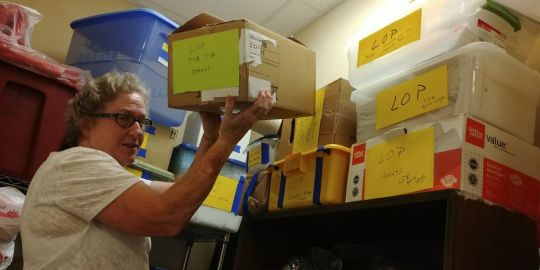
After an afternoon spent organizing, boxing up and labeling altar and gompa supplies for the retreat, Susan Daniel stores the boxes ready to be packed and trucked to the event site, Raleigh, North Carolina, US, July 2017. Photo courtesy of Kadampa Center.
“Supporting conditions for the teachings—oh, my gosh—it’s like a jackpot service opportunity,” said student Rebecca Z. “When Rinpoche arrives at Kadampa Center and we see our membership turn out in force, you get an experience of how profound the retreat is for people. To help be a part of that is unreal.”
Connecting to the larger FPMT family gives student Susan Daniel a quiet sense of satisfaction. After last year’s retreat she went on pilgrimage with Ven. Robina Courtin, and was delighted to encounter new friends that she had made at the Light of the Path 2016 retreat.
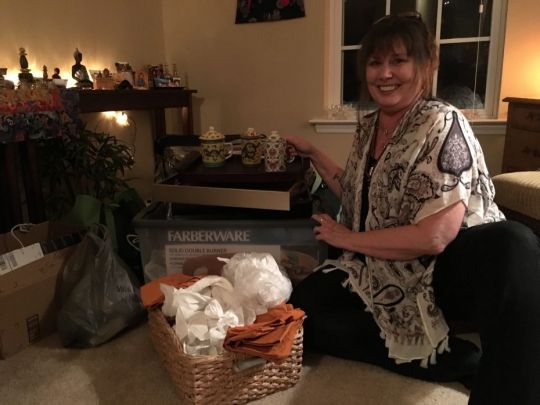
Some Light of the Path supplies are stored in members’ homes. Sandy Carlson checks on mugs for Sangha, Raleigh, North Carolina, US, July 2017. Photo courtesy of Kadampa Center.
For Sandy Carlson, serving Rinpoche and the Sangha puts her in a whole new zone throughout the retreat. “When you give yourself over to service like this, it’s a different mindset,” she said. “I see Rinpoche working with people, see the love that he has for people. I’ve just seen his true wisdom.”
Learn more about how you can prepare for the Light of the Path 2017 retreat on FPMT.org:
https://fpmt.org/edu-news/preparing-for-the-2017-light-of-the-path-retreat/
Mandala brings you news of Lama Zopa Rinpoche and of activities, teachings and events from over 160 FPMT centers, projects and services around the globe. If you like what you read in Mandala, consider becoming a Friend of FPMT, which supports our work.
7
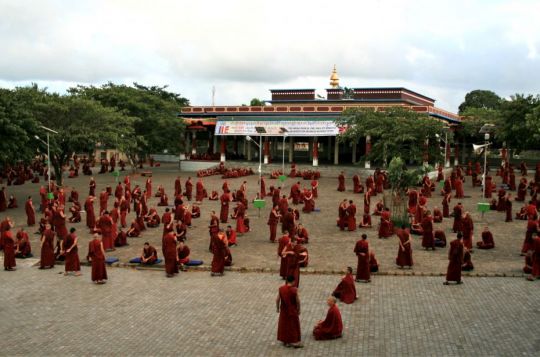
Debate in the courtyard at Sera Je Monastic University, 2009, India. Photo courtesy of Ryan Matsumoto.
In the twenty-minute video below, Sera Je International Mahayana Institute (IMI) monks Vens. Tenzin Gache and Tenzin Legtsok give a demonstration of monastic debate in English, introduced and explained by Ven. Gyalten Lekden.
As the monks and nuns in geshe studies programs in Tibetan monastic institutions normally debate in Tibetan only, no matter what their first language, debate in English is rarely seen, and this video has been made by Claudio Curciotti and the Western monks to show English-speakers how debate works.
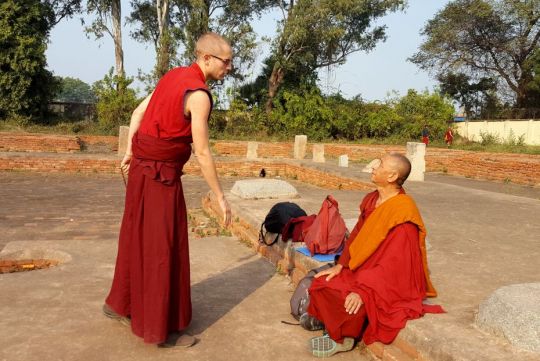
Ven. Tenzin Gache (standing) debates with Geshe Thupten Zopa on the grounds of the ancient university of Nalanda, near Bodhgaya, India, January 2017. Photo by Zarina Osmonalieva.
Debate is a crucial part of monastic education. In a Mandala online article published in 2016, geshe studies student Ven. Tenzin Namjong explained, “By far the main avenue of learning at Sera is debate. Some people are surprised to hear that we have only two or three hours of classes per week. But we debate several hours a day. As we advance, there is even less class time. Once you know how to study, you read a text and then settle your doubts on the debate courtyard … Debate is analytic meditation in action. It isn’t primarily about defeating an external opponent. Rather, we need to recognize and refute our mistaken ways of thinking using reasoning. The answer in and of itself is not that helpful if you haven’t arrived at it through first identifying and then refuting the wrong view … the debate process definitely helps.”
Watch a brief explanation of debate and two short debates on YouTube here:
https://www.youtube.com/watch?v=wkRkF_9zcgs&feature=youtu.be
To learn more about debate and other aspects of geshe studies, and watch a short video of debate in Tibetan, see “Dhi! Ven. Tenzin Namjong on Debate, Study, and Life at Sera Je,” a Mandala online feature.
Watch a video, including some samples of debate in Tibetan, showing FPMT registered teacher and native of the Netherlands Ven. Tenzin Namdak graduating from geshe studies here:
https://www.youtube.com/watch?v=ge_g4YfXza0&feature=youtu.be
Mandala brings you news of Lama Zopa Rinpoche and of activities, teachings and events from over 160 FPMT centers, projects and services around the globe. If you like what you read in Mandala, consider becoming a Friend of FPMT, which supports our work.
28
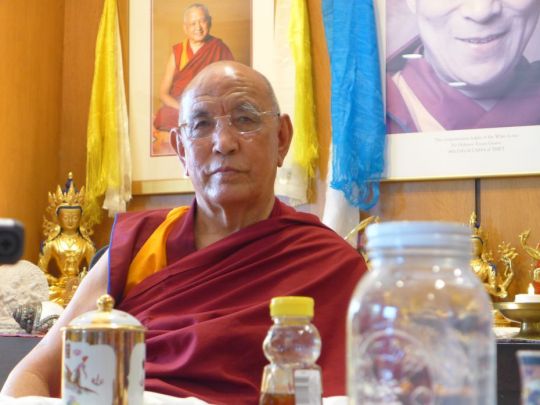
The 104th Ganden Tripa Lobsang Tenzin Rinpoche during a visit to FPMT International Office staff, Portland, Oregon, US, June 25, 2017
The 104th Ganden Tripa Lobsang Tenzin Rinpoche visited FPMT International Office in Portland, Oregon, US, on June 24. The visit came during a three-day teaching event at Maitripa College. Tri Rinpoche, who was formerly known by the title Jangtse Chöje, had just been appointed by His Holiness the Dalai Lama as the 104th Ganden Tripa, the spiritual head of the Gelug school of Tibetan Buddhism. Tri Rinpoche will be officially enthroned later this season.
Mandala Publications and Maitripa College interviewed Tri Rinpoche with the help of Yangsi Rinpoche, one of Tri Rinpoche’s students and president of Maitripa College, as translator. Tri Rinpoche spoke about what it was like living at Sera Monastery in Tibet, the Communist Chinese oppression and violence that he witnessed in 1959, his decision to flee to India, re-establishing Sera in exile, and helping identify Yangsi Rinpoche as the reincarnation of his own beloved teacher, Geshe Ngawang Gendun. The interview will be published by Mandala in the future.
FPMT International Office was honored to receive the 104th Ganden Tripa Lobsang Tenzin Rinpoche. We wish Tri Rinpoche a long and healthy life, pray that all his holy wishes succeed immediately, and hope he will return to Portland, Oregon, soon.
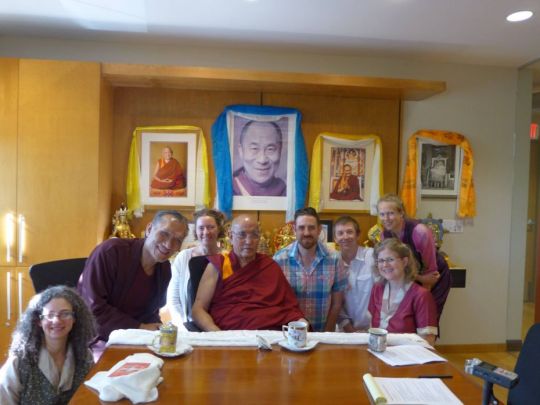
The 104th Ganden Tripa with Yangsi Rinpoche and FPMT International Office and Maitripa College staff, Portland, Oregon, US, June 24, 2017
Mandala brings you news of Lama Zopa Rinpoche and of activities, teachings and events from over 160 FPMT centers, projects and services around the globe. If you like what you read in Mandala, consider becoming a Friend of FPMT, which supports our work.
- Tagged: 104th ganden tripa, ganden tripa, jangtse choje
23
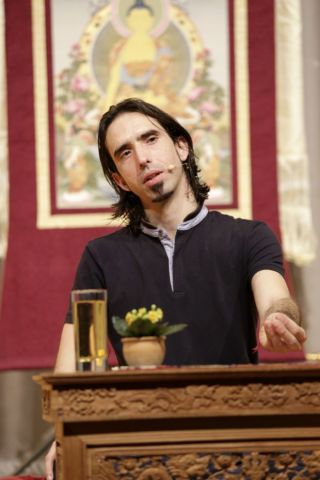
Tenzin Ösel Hita speaking at Aryatara Institut, Munich, Germany, February 2017. Photo by Hermann Wittekopf.
During the first three months of 2017, Tenzin Ösel Hita, the recognized reincarnation of FPMT founder Lama Yeshe, toured European FPMT centers giving talks to hundreds of eager students.
The tour began on January 25 at Maitreya Instituut Amsterdam in the Netherlands with a talk entitled “Easy Ways to Lessen Egoism and Develop Compassion to Increase True Joy.” The next day, Ösel went to Maitreya Instituut Loenen to give an improvised talk to the community of students there.
After the Netherlands, Ösel continued on to the United Kingdom to visit Jamyang Buddhist Centre London and the Foundation for Developing Compassion and Wisdom in the nation’s capital, and Land of Joy, a Buddhist retreat center in the north. Next, Ösel visited Aryatara Institut in Munich, Germany; Tong-nyi Nying-je Ling in Copenhagen, Denmark; Centre Kalachakra in Paris, France; Institut Vajra Yogini and Nalanda Monastery near Toulouse, France; and O.Sel.Ling Centro de Retiros in the Alpujarras of southern Spain.
Watch Tenzin Ösel Hita speak at Aryatara Institut in Munich, Germany, on YouTube:
All of the centers have made recordings of the talks available to the wider FPMT community. Please find a complete list below:
Maitreya Instituut Amsterdam, January 25
Maitreya Instituut Loenen, January 26
Jamyang Buddhist Centre Lodon, January 28
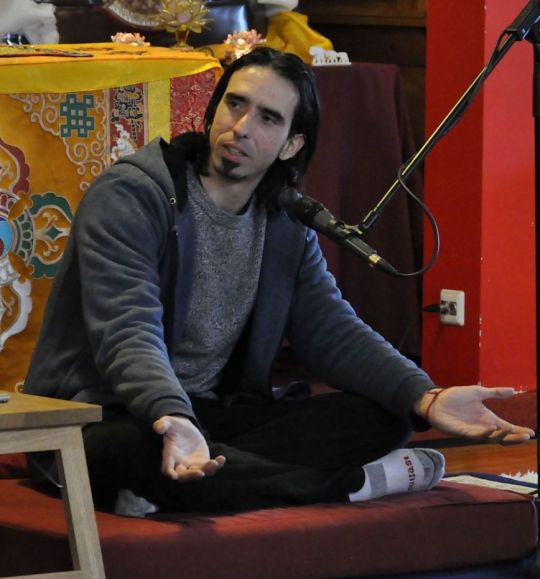
Tenzin Ösel Hita speaking at Maitreya Instituut Loenen, the Netherlands, January 2017. Photo courtesy of Maitreya Instituut Loenen.
Tong-nyi Nying-je Ling, February 11
Centre Kalachakra, February 15
Institut Vajra Yogini, February 17 and February 19
Nalanda Monastery, February 20
O.Sel.Ling Centro de Retiros, March 25
Find more information about Tenzin Ösel Hita on his resource page on FPMT.org, including news, photos, videos, and links to his official Facebook page.
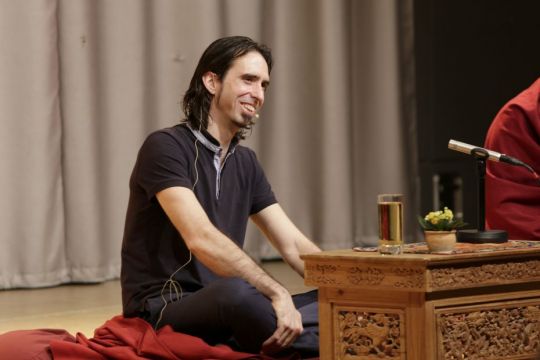
Tenzin Ösel Hita speaking at Aryatara Institut, Munich, Germany, February 2017. Photo by Hermann Wittekopf.
The Big Love Fund provides financial resources that enable Tenzin Ösel Hita to continue his endeavors on behalf of FPMT.
Mandala brings you news of Lama Zopa Rinpoche and of activities, teachings and events from over 160 FPMT centers, projects and services around the globe. If you like what you read in Mandala, consider becoming a Friend of FPMT, which supports our work.
- Tagged: europe, fpmt europe, tenzin osel hita
17
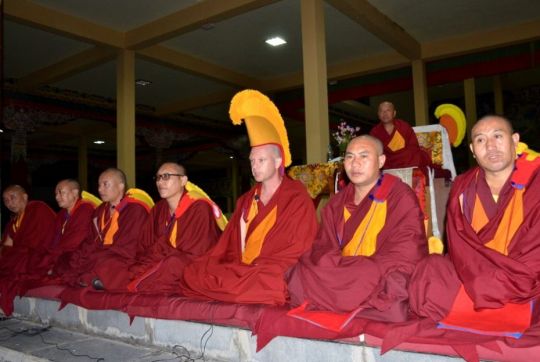
Geshe Tenzin Namdak answering debate questions during the geshe graduation ceremony, Sera Je Monastic University, India, May 2017. Photo courtesy of Sera Jey Audio Visual Center.
Watch the eighteen-minute video below to see the colorful, moving, and joy-filled graduation ceremonies of Geshe Tenzin Namdak, who has completed the full twenty-year course of studies at Sera Je Monastic University in South India and his final geshe examinations there: a tremendous achievement.
On May 8, 2017, Geshe Namdak, a registered FPMT teacher and native of the Netherlands, was officially awarded a geshe degree by Sera Je. He is one of only very few Westerners to have obtained a geshe degree and the first to do the entire course of studies and exams at Sera Je.
This video, filmed and edited by Claudio Curciotti, shows the formal ceremony as well as related activities. It also highlights the friendship and support offered to Geshe Namdak by other Sera IMI monks and Geshe Namdak’s friends and students at Choe Khor Sum Ling (CKSL), the FPMT center in Bangalore, India. Geshe Namdak is also accompanied in parts of the ceremony by his ordained students, including a young Tibetan boy, Jampel Tsering, who lives at Sera IMI house.

Sera IMI monks in the courtyard of IMI house at Sera Je Monastery, India, November 2013. (L to R) Vens. Gyalten Lekden, Tenzin Legtsok, Tenzin Gache, Tenzin Namdak, Jampel Tsering (child), Jampa Khedrup, Losang Khedrup, Tenzin Namjong, Gyalten Choklang. Photo by Sandesh Kadur, November 2013 (The boy monk is Jampel Tsering. He is Ven. Tenzin Namdak’s student and lives with the monks at Sera IMI house). Photo by Sandesh Kadur.
In addition to his geshe studies and helping to establish CKSL at the direction of His Holiness the Dalai Lama and Lama Zopa Rinpoche, Geshe Namdak has benefited others in many ways. These include helping to establish Sera IMI House and serving as its director, organizing and teaching translation courses at Sera Je, translating for various lamas, and helping run pre-ordination courses for new monks and nuns in Dharamsala, India.
While Geshe Namdak speaks only shyly of his great accomplishment, attributing it to the support he has received from his gurus and others, in an interview soon to be published by Mandala, he allows that graduating is an occasion for rejoicing. He adds, “I have been very fortunate that the guru gave me this opportunity!”
Watch Geshe Namdak’s graduation ceremony on YouTube:
https://youtu.be/ge_g4YfXza0
For more about Geshe Tenzin Namdak, see “The Union of Study and Practice,” an article about the benefits of long-term intensive study and practice in Mandala January-June 2016.
To learn more about debate and other aspects of geshe studies, read “Dhi! Ven. Tenzin Namjong on Debate, Study, and Life at Sera Je,” a Mandala online feature.
Mandala brings you news of Lama Zopa Rinpoche and of activities, teachings and events from over 160 FPMT centers, projects and services around the globe. If you like what you read in Mandala, consider becoming a Friend of FPMT, which supports our work.
16
We invite you to read our June 2017 FPMT International Office e-News. This month you’ll find:
- highlights from our most recently posted blogs
- Lama Zopa Rinpoche’s current schedule for 2017 and 2018
- updates from Work a Day for Rinpoche, FPMT International Office’s most popular annual campaign
- new Dharma practice materials from FPMT Education Services, including “A Long Life Prayer for Lama Zopa Rinpoche” by Khadro-la (Rangjung Neljorma Khadro Namsel Drönme) and “A Requesting Prayer to Maratika: The Source of an Ocean of Siddhis” translated by Lama Zopa Rinpoche
- a new Mandala feature interview with Vicki Mackenzie about her new book, The Revolutionary Life of Freda Bedi: British Feminist, Indian Nationalist, Buddhist Nun
… and more!
The FPMT International Office News comes from your FPMT International Office. Visit our subscribe page to receive the FPMT International Office News directly in your email box.
- Tagged: enews
26
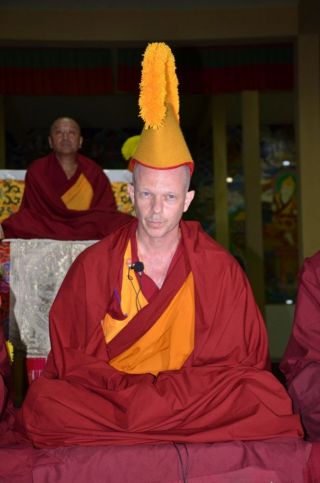
Geshe Tenzin Namdak, Sera Je Monstic University, Bylakuppe, Karnataka , India, May 2017. Photo courtesy of Sera Jey Audio-Visual Department.
On April 26, 2016, Ven. Tenzin Namdak, Sera IMI House monk and FPMT registered teacher, received the title of “Geshe” after completing coursework for the geshe studies program at Sera Je Monastic University in South India. On May 8, he was officially awarded the degree during a three-day ceremony that included public debate, recitation of memorized texts, and pujas. Fellow Sera IMI House monk Ven. Tenzin Legtsok reports:
On May 8, 2017, Ven. Tenzin Namdak, registered FPMT teacher and native of the Netherlands, was officially awarded a geshe degree by Sera Je Monastic University in South India. He is the first Westerner ever to complete the full, formal course of studies at one of the “three seats”—Ganden, Sera, and Drepung monasteries—and sit for the final geshe examination there, too.
There are many steps leading up to the geshe degree. First, one must complete nineteen years of coursework comprising three years studying introductory topics, seven years on the Ornament of Clear Realization, four years on Supplement to the Middle Way, three years on vinaya, two years on abhidharma, and two months each year spent debating Valid Cognition.
After Ven. Namdak completed his exams for the final year of study, Lama Zopa Rinpoche requested the monastery to formally grant him the geshe degree as quickly as possible so that he can begin sharing his knowledge and experience with FPMT centers outside India. In July 2016, this request was granted, and Ven. Namdak began preparing for his final geshe examination ceremony.
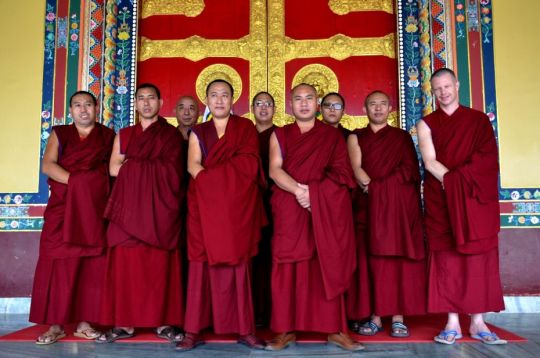
Geshe Tenzin Namdak with fellow graduates, Sera Je Monstic University, Bylakuppe, Karnataka , India, May 2017. Photo courtesy of Sera Jey Audio-Visual Department.
For two weeks leading up to the final ceremony, Geshe Namdak and eight other monks becoming geshes sat for a small debate examination before each class in the geshe studies program. During the actual three-day ceremony, they sat in front of the entire assembly of over 1,000 monks and answered debate questions on the traditional five topics.
As the other eight geshes had primarily qualified to take the final degree through service to the monastery instead of study, Geshe Namdak was the only one among them to take the role of defender, the person who answers the questioner. The highlight, and perhaps most nerve wracking part of Geshe Namdak’s ceremony, was when he had to recite from memory a 25-page long passage from Jetsun Chokyi Gyaltsen’s commentary on Lama Tsongkhapa’s Thorough Elucidation of the Intent in front of the entire assembly!
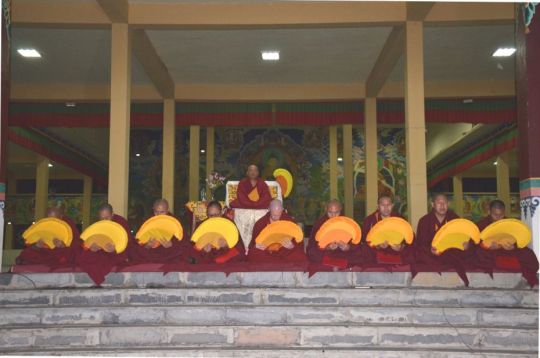
Geshe Tenzin Namdak with fellow graduates, Sera Je Monstic University, Bylakuppe, Karnataka , India, May 2017. Photo courtesy of Sera Jey Audio-Visual Department.
On the day of his examination ceremony Geshe Namdak, offered lunch and a small money donation to each monk at Sera Je. During this puja, he was led in procession through the main temple accompanied by his two ordained students and twelve members of Choe Khor Sum Ling, the FPMT center in Bangalore where he teaches.
The final part of the celebration was the following day, when hundreds of well-wishers came to his residence, Sera IMI House, to make offerings and give their congratulations.

Hundreds of people came to offer khatas and their congratulations to Geshe Tenzin Namdak, Bylakuppe, Karnataka , India, May 2017. Photo courtesy of Ven. Gyalten Lekden.
For more about Geshe Tenzin Namdak, see “The Union of Study and Practice,” an article about the benefits of long-term intensive study and practice in Mandala January-June 2016.
To learn more about the structure and purpose of debate in Tibetan Buddhism, read “Dhi! Ven. Tenzin Namjong on Debate, Study, and Life at Sera Je,” a Mandala online feature.
Mandala brings you news of Lama Zopa Rinpoche and of activities, teachings and events from over 160 FPMT centers, projects and services around the globe. If you like what you read in Mandala, consider becoming a Friend of FPMT, which supports our work.
- Tagged: geshe tenzin namdak
21
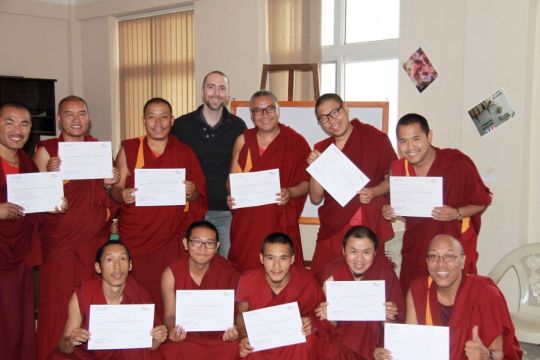
Bertrand Beauregard with some of the “Efficient Communication and Excellence in Management” course graduates, Kopan Monastery, Kathmandu, Nepal, March 2017. Photo courtesy of Bertrand Beauregard.
In March 2017, twenty-four Kopan Monastery monks who also serve in staff positions at the monastery received coaching and training for six days in management, communication, and leadership from French student Bertrand Beauregard, director of Institut International de Coaching Humaniste (IICH). Bertrand offered the tailored training—”Efficient Communication and Excellence in Management”—as part of his service to Lama Zopa Rinpoche.
Using role play, the monks learned and practiced skills in management, cross-cultural communication, and leadership. Also, the monks practiced teamwork building exercises and even got exposure to Myers-Briggs (MBTI) personality profiles to help them relate to others more effectively.
“I would like to thank Bertrand for coming at Kopan Monastery to teach us and share his knowledge,” said attendee Geshe Thubten Chyangchup. “I learned new words and how to communicate with others cultures. I really liked learning how to be a leader, how to use motivational drivers, how to say ‘no,’ and how to give feedback.”
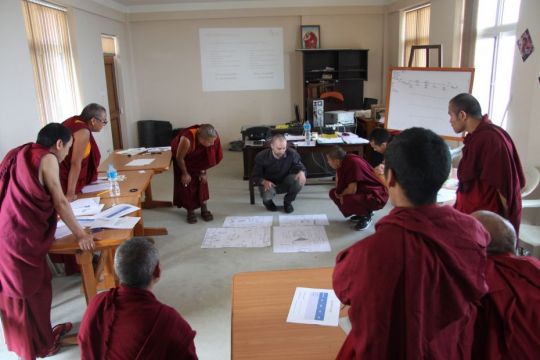
Bertrand Beauregard and some of the “Efficient Communication and Excellence in Management” trainees, Kopan Monastery, Kathmandu, Nepal, March 2017. Photo courtesy of Bertrand Beauregard.
“This training was beyond my expectation,” added Geshe Thubten Jinpa. “I didn’t think it would be before class started, but it fascinated me. I learned so much. It is a bodhisattva action to implement these skills.”
Bertrand was also grateful for the experience. “For me, to train and coach in such an auspicious environment has been a really precious and interesting experience,” Bertrand beamed. “When I’m at Kopan, I’m used to receiving teachings and bowing down to my Dharma teachers—so this was quite different! The students were really open-minded and we could go really deep into communication, management, and teamwork building.”
Bertrand continued, “I was really grateful to share my passion and offer my skills to FPMT. Like in life, it is all about giving and receiving at the same time. We learned so much form each other and I realized, because I was training in a religious organization, that belonging is probably one of the most basic human needs. I would like to thank the entire Kopan family, especially Ani Fran and Vens. Mukhiya and Zoksang, for accommodating me. This has been a great example of compassionate, passionate, and patient teamwork.”
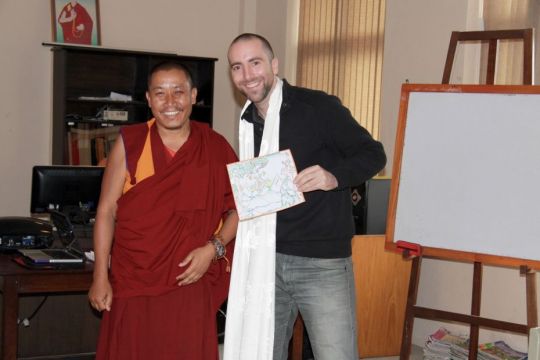
Geshe Thubten Chyangchup offers Bertrand Beauregard a certificate in “Gratitude and Happiness” designed by the young Kopan monks, Kopan Monastery, Kathmandu, Nepal, March 2017. Photo courtesy of Bertrand Beauregard.
Bertrand will offer “Efficient Communication and Excellence in Management” to the staff of Kopan Nunnery and follow up with the Kopan monks in the next few months.
Mandala brings you news of Lama Zopa Rinpoche and of activities, teachings and events from over 160 FPMT centers, projects and services around the globe. If you like what you read in Mandala, consider becoming a Friend of FPMT, which supports our work.
19
We invite you to read our May 2017 FPMT International Office e-News. This month you’ll find:
- a new, dynamic photo album chronicling Lama Zopa Rinpoche’s beneficial activities during March–April 2017 in Nepal
- a thank-you message to all who have started doing practices for Rinpoche’s long, healthy life
- a collection of revised protector prayers recommended by Rinpoche
- updates on FPMT International Office’s Supporting Ordained Sangha Fund
- “The Benefits of Monasteries and Nunneries,” Mandala‘s newest online feature story
- a list of the award recipients for the International Merit Box 2017
… and more!
The FPMT International Office News comes from your FPMT International Office. Visit our subscribe page to receive the FPMT International Office News directly in your email box.
- Tagged: enews
12
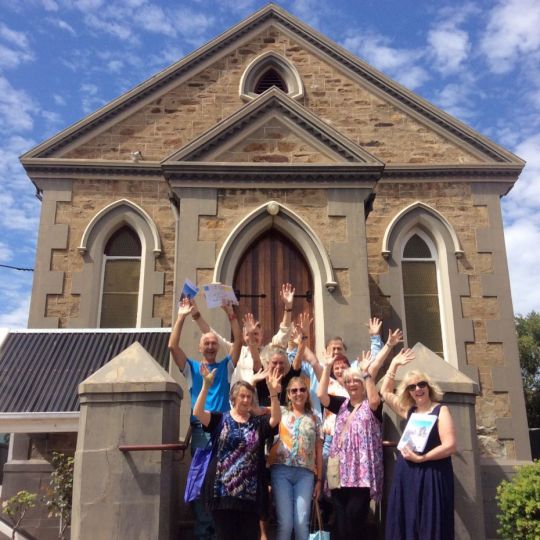
Buddha House board members successful bid on an 1866 bluestone church, Magill, South Australia, Australia, February 2016. Photo courtesy of Buddha House.
On May 12, 2017, Buddha House in the suburbs of Adelaide, Australia, celebrated one year since receiving the keys to its new property and beginning extensive renovations. Buddha House student Carole Migalka described the process of finding the 1866 bluestone church its community now calls home:
“From humble beginnings in a student’s shed after Lama Yeshe’s visit in 1982, Buddha House in Adelaide has grown and flourished into a well-established FPMT center. The pioneer community purchased and renovated the first premises, a residential home, which over the years outgrew the local council bylaws. This forced the center into lease for over a decade while looking for a suitable property to purchase with limited funds.
“During the Bendigo retreat in 2014 a group of Buddha House students met with Lama Zopa Rinpoche to ask for advice about how to develop the center. His advice included doing regular specific practices together and having statues made to create the merit and conditions to finance a new center.
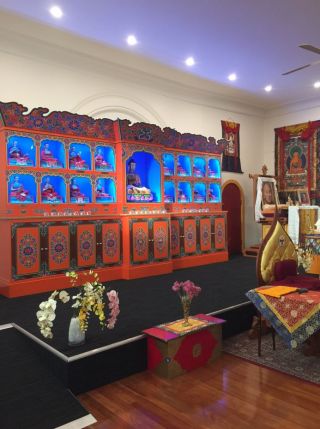
New Buddha House altar with Sixteen Arhats statues, Magill, South Australia, Australia, May 2017. Photo courtesy of Buddha House.
“A statue fund was formed, members and friends donated generously, and the two advised statues were commissioned. At that time Rinpoche also explained the merits of having the Sixteen Arhats statues at FPMT centers and these were made for us at Nalanda Monastery. In November 2015 the Arhats arrived in Australia ready to be painted, filled, and consecrated. Shortly after this, financial support in the form of a loan was offered to Buddha House to assist us in the purchase of our own property, coinciding with the auction of a heritage listed church and hall only eight minutes from the existing center!
“Checks were carried out by Rinpoche for its suitability. Prayers, practices, and pujas were advised and hastily completed with world-wide support, including the making of 1,000 Ganapati tsa-tsas. This task was completed by volunteers at Chenrezig Institute in five days before the date of auction.
“On February 13, 2016, the Buddha House board gathered in front of the church to successfully bid—the only offer!
“One year has passed since settlement and with great effort by many volunteers, generous donations, numerous working bees, and a dedicated building committee, an old run-down property has been transformed. The result is a wonderful Dharma center with the gompa housed in the heritage chapel, a Dharma shop and office at the entrance, a community lounge and café in the center, and a large hall and courtyards at the rear that is available for hire by local community groups.
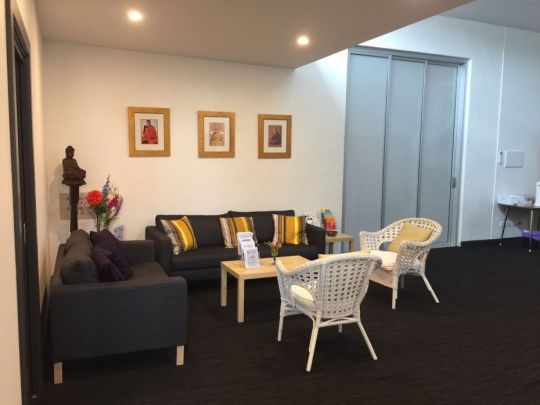
Completed Buddha House lounge, Magill, South Australia, Australia, May 2017. Photo courtesy of Buddha House.
“At the request of our kind and skillful sponsor, a loan repayment agreement has been reached between Buddha House and the Great Stupa of Universal Compassion in Bendigo, enabling us to directly assist this wonderful project!
“In keeping with Lama Yeshe’s vision, Buddha House aspires to continue growing and attracting people to the center, enabling generations of sentient beings to generate merit and benefit from the pristine and inspirational teachings of the Buddha.”
Mandala brings you news of Lama Zopa Rinpoche and of activities, teachings and events from over 160 FPMT centers, projects and services around the globe. If you like what you read in Mandala, consider becoming a Friend of FPMT, which supports our work.
- Tagged: australia, buddha house
23
We are saddened to share the news of the passing of the 103rd Ganden Tripa Jetsun Lobsang Tenzin Rinpoche, who died on April 21, 2017, at 11:45 p.m. in Delhi, India, after an illness. According to the Central Tibetan Administration, the Ganden Tripa’s death was announced by Gelugpa members of the Tibetan Parliament in exile, who urged devotees to do special prayers for the Ganden Tripa.
Sikyong (Prime Minister) Dr. Lobsang Sangay, the head of the Tibetan government in exile, said, “With profound sadness, I on behalf of all Tibetans pray that Kyabje Jetsun Lobsang Tenzin Rinpoche will be reborn and carry forward his mission to spread the teachings of Lord Buddha and His Holiness the Dalai Lama. … May he be reborn in Tibet, the land of snow.”
The 103rd Ganden Tripa Jetsun Lobsang Tenzin Rinpoche, who served as the head of the Gelug school of Tibetan Buddhism, was appointed by His Holiness the Dalai Lama in October 2016. He was enthroned on November 5, 2016, at Ganden Trithok Khang in Mundgod, India, succeeding Rizong Sey Thubten Nyima Lungtok Tenzin Norbu in the position.
According to the Central Tibetan Administration, the 103rd Ganden Tripa was born in 1937 in Eastern Tibet. He joined Tsem Monastery at age nine and later received his higher education at Drepung Loseling Monastic University. In 1959, he followed His Holiness into exile and continued his geshe studies in Buxa Duar, a former prison camp where refugee monks were housed for several years. When the major monasteries were reestablished in South India, he served Drepung Loseling Monastery in various capacities. He was awarded the Geshe Lharampa degree in 1982 and attended Gyuto Tantric College the following year. In 2003, he was enthroned as Sharpa Chöje at the Ganden Monastery.
Becoming the Ganden Tripa
from Mandala January-June 2016
Ganden Tripa, which can be translated as “holder of the Ganden throne,” is the title given to the head of the Gelug school of Tibetan Buddhism. Unlike reincarnation lineages, the Ganden Tripa is an appointed position based on knowledge and merit, and held for seven years. There is a saying in the monasteries that “If a mother’s child has the knowledge and wisdom, then there is no ownership of the Ganden throne,” meaning that any monk who has the intelligence and makes the effort could eventually become the Ganden Tripa.
In order to progress into the position of Ganden Tripa, a monk must first achieve the Lharampa Geshe degree, the highest degree awarded by the Gelug monasteries, and then study for at least one year and take exams at one of the tantric colleges—Gyuto or Gyume. After that, the geshe would have to be appointed to serve as the tantric college disciplinarian and then be chosen as the head lama of ritual ceremonies, an appointment currently made by His Holiness the Dalai Lama. From that position, he would become the abbot of the tantric college for three years. The former abbots of the tantric colleges are in line to be appointed as the Jangtse or Sharpa Chöje, coming from Gyume and Gyuto Tantric Colleges respectively. The Jangtse and Sharpa Chöjes alternate in eventually becoming the Ganden Tripa.
The first Ganden Tripa was Lama Tsongkhapa (1357–1419), who founded the Gelug lineage. His disciples Gyaltsab Je and Khedrup Je were the second and third Ganden Tripas respectively.
For more on the life and death of the 103rd Ganden Tripa, you can read the Central Tibetan Administration’s Tibet.net article in its entirety. You can also visit the Ganden Tripa’s Facebook page.
- Tagged: ganden tripa
21
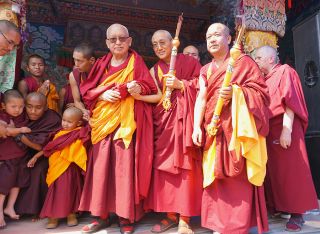
Lama Zopa Rinpoche with Thubten Rigsel Rinpoche, Khen Rinpoche Geshe Chonyi, and Losang Namgyal Rinpoche, Kopan Monastery, Nepal, March 2017. Photo by Ven. Lobsang Sherab.
We welcome you into our April FPMT International Office e-News – out now!
Click to find:
- Practices to do for Lama Zopa Rinpoche’s Health, and a Highlighted Teaching from Rinpoche
- New Additions to Rinpoche’s Schedule
- New Mandala ebook
- Highlighted Retreats At FPMT Centers
and more….!
The FPMT International Office News comes from your FPMT International Office. Visit our subscribe page to receive the FPMT International Office News directly in your email box.
- Home
- News/Media
- Study & Practice
- About FPMT Education Services
- Latest News
- Programs
- New to Buddhism?
- Buddhist Mind Science: Activating Your Potential
- Heart Advice for Death and Dying
- Discovering Buddhism
- Living in the Path
- Exploring Buddhism
- FPMT Basic Program
- FPMT Masters Program
- FPMT In-Depth Meditation Training
- Maitripa College
- Lotsawa Rinchen Zangpo Translator Program
- Universal Education for Compassion & Wisdom
- Online Learning Center
- Prayers & Practice Materials
- Overview of Prayers & Practices
- Full Catalogue of Prayers & Practice Materials
- Explore Popular Topics
- Benefiting Animals
- Chenrezig Resources
- Death & Dying Resources
- Lama Chopa (Guru Puja)
- Lama Zopa Rinpoche: Compendium of Precious Instructions
- Lama Zopa Rinpoche: Life Practice Advice
- Lama Zopa Rinpoche Practice Series
- Lamrim Resources
- Mantras
- Prayer Book Updates
- Purification Practices
- Sutras
- Thought Transformation (Lojong)
- Audio Materials
- Dharma Dates – Tibetan Calendar
- Translation Services
- Publishing Services
- Teachings and Advice
- Find Teachings and Advice
- Lama Zopa Rinpoche Advice Page
- Lama Zopa Rinpoche: Compendium of Precious Instructions
- Lama Zopa Rinpoche Video Teachings
- ༧སྐྱབས་རྗེ་བཟོད་པ་རིན་པོ་ཆེ་མཆོག་ནས་སྩལ་བའི་བཀའ་སློབ་བརྙན་འཕྲིན།
- Podcasts
- Lama Yeshe Wisdom Archive
- Buddhism FAQ
- Dharma for Young People
- Resources on Holy Objects
- Ways to Offer Support
- Centers
- Affiliates Area
- Teachers
- Projects
- Charitable Projects
- Make a Donation
- Applying for Grants
- News about Projects
- Other Projects within FPMT
- Support International Office
- Projects Photo Galleries
- Give Where Most Needed
- FPMT
- Shop
Subscribe to FPMT News
Translate*
*powered by Google TranslateTranslation of pages on fpmt.org is performed by Google Translate, a third party service which FPMT has no control over. The service provides automated computer translations that are only an approximation of the websites' original content. The translations should not be considered exact and only used as a rough guide.Living in morality is one fundamental spiritual practice that is a very important source of happiness for you and for all living beings. This is also one of the best contributions that you can give to this world, for world peace.







